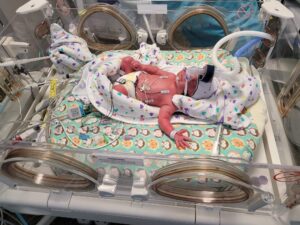
Wondering which baby gear, you need to add to your baby shower registry? Have you heard of “Container Baby Syndrome?”
Perhaps your pediatrician mentioned “container baby syndrome” and you’re wondering about healthy infant development.
If you walk the aisles of any big box store, there’s no shortage of brightly colored and comfy looking baby gear. Your registry checklists has loads of baby gear listed.
If baby gear, also referred to as containers, are so popular, they must serve an important purpose for infants, right?
Stores and manufacturers are great at marketing these items as necessary. Many suggest you need them to help your child reach milestones or to learn independence from an early age.
However, overuse of baby gear can lead to Container Baby Syndrome. Experts want parents to be aware that many of these items can harm your baby’s development.
What Are Baby Containers?
Baby containers are any device which limits your baby’s movement. This includes:
- Infant swings
- Bouncy seats or sitting ‘support’ style seats
- Car seats
- Jumpers, exersaucers, and walkers
- Pillows, cushions – including positioning pillows
- Infant carriers – babywearing
As you can see by this list, some baby gear is vital. Always use a car seat in a moving vehicle to keep baby safe.
Babywearing can be an excellent way to meet your baby’s need for touch, bonding, or even feeding while you’re up and about.
Utilizing baby gear isn’t inherently harmful. However, overusing some baby gear can have a negative effect on your baby’s development.
Pediatric physical therapist and early childhood expert, Wendy Rohin, PT, DPT works to inform parents of the importance of movement during infancy.
She shared, “In the first year of development, movement is learning. When babies and toddlers are left in their car seats, swings and sitting devices, passively taking in all stimuli without movement, they are not learning.”
When a baby spends excess time in a car seat outside of the car or significant time in any container, they could develop Container Baby Syndrome.
What Is Container Baby Syndrome?
During your baby’s checkups, her pediatrician will assess her overall development.
In the absence of other known health conditions, they might consider Container Baby Syndrome if they notice:
- Delays in reaching milestones such as not rolling, sitting or pulling to stand at the appropriate age
- Tightness of the neck leading to baby keeping her head turned and tilted to one side – this is known as torticollis
- Flat spots on the head from a lack of movement – this is known as plagiocephaly
For babies already at risk for developmental delays, such as preemies or babies with medical conditions, the side effects of excess time in containers is higher.
If your baby is experiencing any of the above, spending too much time in a container could be the problem.
Some babies are born with congenital torticollis. This isn’t caused by using containers, though they can worsen the problem and increase the risk of flat head syndrome.
Container Baby Syndrome may cause acquired torticollis in an older infant.
Is Container Baby Syndrome Dangerous?
Anytime we hear the word syndrome, it’s easy for our minds to go to a very serious medical problem. While Container Baby Syndrome is not a serious medical condition, it has a big impact on development.
It should be taken seriously. Spending too much time in a container can impact:
- Meeting milestones
- Muscle tightness, especially in the neck
- Positional abnormalities of the head – plagiocephaly
- Social skills
- Language development
- Muscle strength
- Sensory processing difficulties
Being in a chair limits baby’s ability to move and build muscle strength. It also reduces the amount of time babies spend naturally exploring their environment – an important part of development.
Meghan Krouse, a licensed clinical social worker and certified sensory enrichment therapist shared, “The brain craves novelty in balance with new sensory exposure. I remember my son learning to crawl and he would go from a warm, fuzzy carpet, to a cool tile, to a rough little step, and to the rough stone porch. The exposure to changes in temperature and texture, that happen naturally during exploration, stimulates the brain to grow and learn.”
In addition to physical and sensory development, excess time in a container can mean less bonding time and less social interaction.
How Is Container Baby Syndrome Treated?
If your baby’s doctor is concerned about container baby syndrome, or any delay in milestones, he’ll refer for a developmental evaluation.
Depending on where you live, this may mean a specialist physician, early intervention program, or a pediatric physical therapist.
It’s also important to limit your baby’s time in any containers. Use a car seat only when you’re in a vehicle. Wearing your baby rather than overusing a swing or bouncy seat can be excellent to reduce flat head syndrome.
Babywearing can restrict some movement, but it still allows baby to strengthen neck and core muscles. You can even use babywearing instead of a pram when out and about.
The Most Important Thing – Tummy Time
The most important thing you can do to reduce or treat container baby syndrome is practicing lots of tummy time. Placing your baby on her tummy for about 90 minutes per day can help in reaching appropriate milestones.
The 90 minutes do not need to be consecutive, just throughout the day. If your baby is upset, you can lay on your back while she has tummy on your chest.
If the developmental evaluation confirms container baby syndrome or any other delays, a variety of therapies may be prescribed.
Your baby will likely receive physiotherapy to help build muscle strength and coordination. Depending on age and delays, occupational and speech therapy may also be indicated. These therapies can help your baby build strength and reach milestones.
Regarding therapy, Krouse said, “When problems with development or sensory integration occur, we try to create diverse sensory experiences as part of the therapy.
“It’s important to implement therapy. There are many precursors layered into infant development that set the stage for later learning and development. For example, a child’s ability to crawl. This coordinated use of left and right sides helps build the corpus collosum part of the brain which coordinates the left and right sides of the brain.
“Things like focus and proper eye tracking are important for future reading, math, etc.”
It can be overwhelming to hear your child isn’t meeting milestones. Fortunately, early therapy and less time with restricted movement can help your little one catch-up.
How Can I Prevent Container Baby Syndrome?
Perhaps you’re still preparing your baby shower registry. Or, maybe your doctor has expressed some concern about early signs of container baby syndrome and you’re looking to prevent it.
There are many things you can do to prevent container baby syndrome including:
- Using a car seat only in your vehicle
- Babywear rather than always setting baby down
- Limit time in any bouncy seats or swings
- Avoid using sitting devices
- Put baby to sleep on her back on a flat firm surface instead of a swing, rocker, etc.
- Practice about 90 minutes of tummy time per day
- Spend plenty of time making eye contact, singing, talking and playing with your baby
- Avoid baby walkers – they can delay walking and increase risk of injury
- If your baby was premature or has medical conditions, request referrals for therapy programs, even if it’s just for monitoring
If you’re struggling to find ways to keep your baby active and engaged, mommy and me type classes can also be helpful.
While my daughter didn’t have container baby syndrome, her delays related to prematurity were nearly identical. Implementing therapy was huge but adding a fun mommy and me class also aided in her reaching milestones.
The director of the children’s gym she attends shared how it helped, “We see that ‘motion is lotion’ for a child’s brain. The more they move and the more they’re stimulated in a multi-sensory environment, the better their brain develops.
“By stimulating a child’s brain with movement, you’re creating more pathways and connections (neuron and synapses development). This helps your child to be able to not only learn but retain information later in their lives. If they’re not yet moving on their own, then all the more reason to provide stimulation and passive resistance exercises like what we do in an infant gym class.”
A class isn’t a necessity for your infant to reach milestones. However, if you’re looking for more ideas to help their development, it can be a great place to learn.
What Do Parents Need To Know About Baby Gear?
If you’re still preparing for baby’s arrival and wondering which devices to get, remember that they shouldn’t be spending excess time in them. While stores are excellent at marketing, you don’t need devices to reach milestones.
A walker will not help with learning to walk and may interfere with their muscle development. A sitting device doesn’t teach proper sitting and can lead to weak core muscles.
The big box stores won’t tell you this, but the best way for your baby to reach milestones is plenty of tummy time on the floor.
This doesn’t mean you should never use containers, but it’s important not to overuse them.

